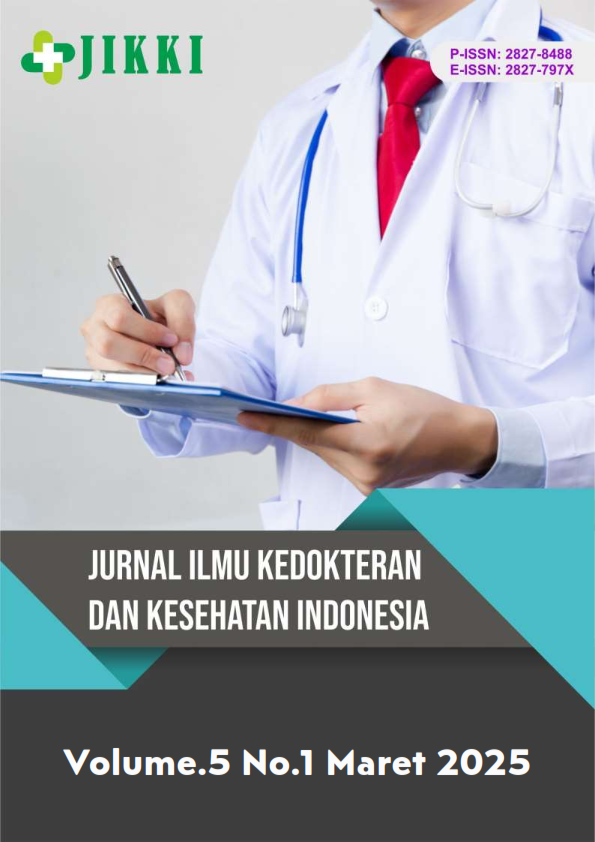Hubungan Kecerdasan Emosional dengan Bullying Victimization pada Mahasiswa Ilmu Kesehatan di Sumatera Barat
DOI:
https://doi.org/10.55606/jikki.v5i1.7110Keywords:
Bullying Victimization, emotional intelligence, health studentsAbstract
This study aims to determine the relationship between emotional intelligence and bullying victimization in health science students in West Sumatra. The study used a quantitative method on 383 health science students in West Sumatra. The instrument in this study was made by the researcher himself, where the emotional intelligence scale refers to the theory put forward by Mayer (2004) and the bullying victimization scale refers to the theory of Smith et al. (1999). The results of the study showed that there was a significant negative relationship between emotional intelligence and bullying victimization (r = -0.154, p <0.05). The results of this study indicate that the higher the level of emotional intelligence, the lower the bullying victimization experienced by health science students in West Sumatra. Conversely, a low level of emotional intelligence can increase the possibility of becoming a victim of bullying in health science students in West Sumatra.
References
Albagawi, B. (2018). Emotional Intelligence Among the Fourth Year Nursing Students: A cross-sectional study. Advances in Social Sciences Research Journal, 5(11), 561–569. https://doi.org/10.14738/assrj.511.5732
Annisa, R. (2020). Analisis Kecerdasan Emosional Mahasiswa Tingkat II Program Studi S1 Ilmu Keperawatan Fakultas Ilmu Kesehatan Universitas Muhammadiyah Cirebon. 1–8.
Ayuni Despa. (2021). Pencegahan Bullying dalam Pendidikan Anak Usia Dini. Journal of Education Research, 2(3), 93–100.
Baroncelli, A., & Ciucci, E. (2014). Unique effects of different components of trait emotional intelligence in traditional bullying and cyberbullying. Journal of Adolescence, 37(6), 807–815. https://doi.org/10.1016/j.adolescence.2014.05.009
Bru-Luna, L. M., Martí-Vilar, M., Merino-Soto, C., & Cervera-Santiago, J. L. (2021). Emotional intelligence measures: A systematic review. Healthcare (Switzerland), 9(12), 1–36. https://doi.org/10.3390/healthcare9121696
Chasanah, U., Marliana, T., & Sulasmy, D. (2015). Dampak bullying pada mahasiswa keperawatan di dki jakarta dalam perspektif kesehatan jiwa. Jurnal Bidang Ilmu Kesehatan, 5(1), 356–377. http://ejournal.urindo.ac.id/index.php/kesehatan/article/view/107
Cirendeu. (2023). Bullying Terjadi Di Fakultas Ilmu Keperawatan Umj, Tindakan Apa Yang Akan Dilakukan Pihak Kampus. Cirendeu. https://www.suaraperubahan.id/2023/10/bullying-terjadi-di-fakultas-ilmu.html
Curtis, J., Bowen, I., & Reid, A. (2007). You have no credibility: Nursing students’ experiences of horizontal violence. Nurse Education in Practice, 7(3), 156–163. https://doi.org/10.1016/j.nepr.2006.06.002
Daranindra, K. C., Iskandarsyah, A., & Setyowibowo, H. (2024). Gambaran Tingkat dan Sumber Stres Mahasiswa Profesi Rumpun Ilmu Kesehatan Universitas Padjadjaran. EduInovasi: Journal of Basic Educational Studies, 4(1), 320–329. https://doi.org/10.47467/edu.v4i1.1280
Elghazally, N. M., & Atallah, A. O. (2020). Bullying among undergraduate medical students at Tanta University, Egypt: a cross-sectional study. Libyan Journal of Medicine, 15(1). https://doi.org/10.1080/19932820.2020.1816045
León-Del-barco, B., Lázaro, S. M., Polo-Del-río, M. I., & López-Ramos, V. M. (2020). Emotional intelligence as a protective factor against victimization in school bullying. International Journal of Environmental Research and Public Health, 17(24), 1–11. https://doi.org/10.3390/ijerph17249406
Lisa Dwi Lastary, & Anizar Rahayu. (2018). Hubungan Dukungan Sosial dan Self Efficacy dengan Prokrastinasi Akademik Mahasiswa Perantau yang Berkuliah Di Jakarta. Ikraith-Humaniora, 2(2), 17–23.
Lomas, J., Stough, C., Hansen, K., & Downey, L. A. (2012). Brief report: Emotional intelligence, victimisation and bullying in adolescents. Journal of Adolescence, 35(1), 207–211. https://doi.org/10.1016/j.adolescence.2011.03.002
Malay, M. N. (2022). Belajar Mudah & Praktis (Analisis Data Stastistik dan JAPS). In CV. Madani Jaya.
Mayer, J. D. (2004). What Is Emotional Intelligence? Research Institutes, Centers and Programs.
Mayer, J. D., Salovey, P., Caruso, D. R., & Cherkasskiy, L. (2017). Emotional Intelligence. 528–549.
Moore, S. E., Norman, R. E., Suetani, S., Thomas, H. J., Sly, P. D., & Scott, J. G. (2017). Consequences of bullying victimization in childhood and adolescence: A systematic review and meta-analysis. World Journal of Psychiatry, 7(1), 60. https://doi.org/10.5498/wjp.v7.i1.60
Nisfiannoor, M. (2009). Pendekatan statististika Modern untuk Ilmu Sosial. Salemba Humanika. https://www.google.co.id/books/edition/Pendekatan_statististika_Modern_untuk_Il/1j_O7aHTZD8C?hl=id&gbpv=1&dq=nisfiannoor+2009&pg=PR2&printsec=frontcover
Novita, N. (2023). Pengaruh Atmosfir Akademik Dan Efektifitas Pendidikan Kewirausahaan Terhadap Pengembangan Karakter Mahasiswa. Jurnal Bisnis Kompetitif, 2(1), 47–56. https://doi.org/10.35446/bisniskompetif.v2i1.1417
Pebriana, S. H. A., & Supriyadi, S. (2024). Fenomena Verbal Bullying Siswa Sekolah Dasar. Jurnal Pendidikan Guru Sekolah Dasar, 1(3), 13. https://doi.org/10.47134/pgsd.v1i3.401
Rasyid, A. R., Amanda, D., Aulya, N., Aswandi, & Anugrah, A. (2024). Peran Pendidikan dalam Membentuk Karakter Mahasiswa. Innovative: Journal Of Social Science Research, 4(Vol. 4 No. 3 (2024): Innovative: Journal Of Social Science Research (Special Issue)), 836–852. https://j-innovative.org/index.php/Innovative/article/view/10500/8115
Ratnasari, S. L., Supardi, S., & Nasrul, H. W. (2020). Kecerdasan Intelektual, Kecerdasan Emosional, Kecerdasan Spiritual, Dan Kecerdasan Linguistik Terhadap Kinerja Karyawan. Journal of Applied Business Administration, 4(2), 98–107. https://doi.org/10.30871/jaba.v4i2.1981
Rospenda, K. M., Richman, J. A., Wolff, J. M., & Burke, A. (2014). Consequences for Alcohol Use. 32(4), 1–20. https://doi.org/10.1080/10550887.2013.849971.Bullying
Sahir, H. S. (2021). Metodologi Penelitian. KBM INDONESIA.
Saifuddin, A. (2020). Penyusunan Skala Psikologi. Kencana. https://books.google.co.id/books/about/Penyusunan_Skala_Psikologi.html?id=H4P1DwAAQBAJ&redir_esc=y
Setiawan, A., & Alizamar, A. (2019). Relationship Between Self Control And Bullying Behavior Trends in Students of SMP N 15 Padang. Jurnal Neo Konseling, 1(4), 1–7. https://doi.org/10.24036/00182kons2019
Simbolon, M. (2012). Perilaku Bullying pada Mahasiswa Berasrama. Jurnal Psikologi, 39(2), 233–243. https://doi.org/10.5040/9798216005261.ch-004
Smith, P. K., Morita, Y., Junger-Tas, J., Olweus, D., Catalono, R., & Slee, P. (1999). The Nature of School Bullying. In The Nature of School Bullying. Routledge. https://doi.org/10.4324/9781315812397
Sreckovic, M. A., Brunsting, N. C., & Able, H. (2014). Victimization of students with autism spectrum disorder: A review of prevalence and risk factors. Research in Autism Spectrum Disorders, 8(9), 1155–1172. https://doi.org/10.1016/j.rasd.2014.06.004
Wardani, L. K., & Fajriansyah, F. (2017). Perilaku Bullying Mahasiswa Kesehatan. Journal Of Nursing Practice, 1(1), 17–23. https://doi.org/10.30994/jnp.v1i1.18
Zhang, Y., & Chen, J. K. (2023). Emotional Intelligence and School Bullying Victimization in Children and Youth Students: A Meta-Analysis. International Journal of Environmental Research and Public Health, 20(6). https://doi.org/10.3390/ijerph20064746.
Downloads
Published
How to Cite
Issue
Section
License
Copyright (c) 2025 Jurnal Ilmu Kedokteran dan Kesehatan Indonesia

This work is licensed under a Creative Commons Attribution-ShareAlike 4.0 International License.








